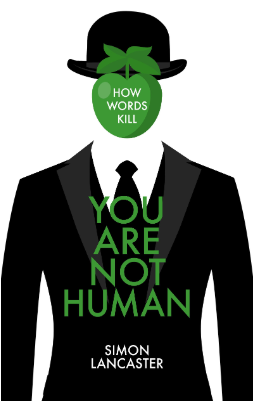You Are Not Human
How Words Can Kill


Simon Lancaster is a leading speechwriter having worked with senior politicians in the UK and prominent business leaders globally. He is an executive fellow at Henley Business School and also lectures at Cambridge University. His 2016 TEDx Verona talk, ‘Speak Like a Leader’ has been viewed over 2 million times.
Words make the world go around. Almost nothing we would like to happen happens without some degree of communication. But how much do we know about the hidden power of good rhetoric? Metaphor has become a much explored theme in leadership recently, and Lancaster’s background as a speechwriter brings intimate knowledge of how to leverage metaphor in practice; his academic research brings deep knowledge of its use and influence through the ages from Ancient Greece to the modern day. As he makes clear, simile is when we liken one thing to another, which is far less powerful than metaphor, which equates one thing as actually being another. In rhetoric metaphor is the granddaddy of influencing techniques. He uses the hierarchy of the 16th century Chain of Being to illustrate that, for a long-time, we have been enthralled to the notion of humans sitting between an omnipotent God that creates wonder and awe in us, and the low-life of animals that can evoke degradation and disgust.
The irony with metaphor is that while the speaker or author is using it to paint an image of one thing as another, ‘the financial storm’, ‘the Arab Spring’… these are illusory, in reality there was no storm, nor Spring. “Welcome to the mysterious world of metaphor, in which everything is something it is not” he says. In spite of this, we use metaphor in our discourse the whole time, “on average six times a minute, or once every sixteen words…our capacity for metaphor means we could imagine where others [ie non-HomoSapiens] could only see. It [the angular gyrus within our brains, and the cognitive revolution 50,000 years ago] gave us our uniquely human qualities of imagination, innovation and ingenuity”.
The core of the book lies in Lancaster’s encyclopaedic knowledge of the history and use of metaphor…and its extraordinary power. He illustrates this by describing the complexity of the UK’s National Health Service (NHS), a million person organization that inevitably is perceived differently by different groups. The politicans who shape its rules, describe it as a child, of which Parliament was its parent, talking about making it ‘fitter and stronger, and able to stand on its own feet’; the managers who run it however, describe it as a car ‘driving change’ and ‘accelerating reforms’, this reinforces their sense of being the driver and in charge. The clinicians dislike this as they are demoted to being cogs and wheels, they prefer to describe it, ironically, as a soldier ‘fighting obesity’, ‘battling cancer’ or ‘beating disease’. The patients often eschew all of these images seeking something more caring and personal. How we relate to issues and organizations in terms of these metaphors shapes our actions and attitudes, and allows us to be swept up in movements that we may not really endorse if the situations had been described more literally.
The news in the U.K. in early 2018 was captivated by the distressing story of Alfie Evans, a two year old who was on a ventilator in hospital unable to live without serious medical assistance. His parents grew an international level of support for him to be kept alive against his doctors’ advice. Lancaster conducted some research at the time asking 200 people whether his life-support should be turned-off. 100 were asked the question with his condition being described as ‘an unknown neurological condition’, the other 100 got the same question but that phrase replaced with ‘semi-vegetative state’. The first 100 responded 2:1 against turning off the ventilator; the second group were 3:2 in favour of doing so. Metaphor, here ‘semi-vegetative’, can have life or death consequences.
The book explores a wide variety of metaphors in current usage, both negative: trolls, scum, vermin; and positive: star, angels, family, amongst others and explains and illustrates how influential these words can be in framing our thinking about issues and people.
In most situations we are not dealing with life and death scenarios, but understanding the extremes is important to understand the less obvious, more nuanced influence that happens in everyday conversation and lobbying. Lancaster quotes Aldous Huxley’s 1936 speech “Most people would hesitate to torture or kill a human being like themselves. But when that human being is spoken of as though he were not a human being….we lose our scruples”.
“When language changes, so do attitudes, and finally behaviours” explains Lancaster. This is, as you would expect from a speechwriter, a hugely engaging and readable book packed with stories and personal anecdote. The message is simple though, that regardless of the power of the oration and the strength of the images, no-one is a actually a vegetable, or scum, or an angel or a star – we are all human.
Title: You Are Not Human, How Words Can Kill
Author/s Name/s: Simon Lancaster
Publisher: BiteBack Publishing
ISBN: 978-1-785-90407-3
Publishing Date: September, 2018
Number of Pages: 297
Author Knowledge Rating: 1-5 (based on their years of experience, academic expertise in subject areas, and exposure to cross-functional thinking in the area)





































































Readability: 1-5 score(1=dense and v academic; 5=frantic; page turner)





















































































Appropriate Length: (1=could have been written in 25% of the length;5=could have been longer)





























































Core Idea Value: (1=nonsense (or entirely esoteric); 5=game-changer)




























































